Plugin User Guides
Spiritbox - Mike Stringer User Guide
Last updated on 21 Oct, 2025
The following article is a condensed version of the user guide. You can learn about more features under the Plugin Interface Overview .
Overview
Drawing inspiration from the most unexpected sources, his sound and style transcend the ordinary, setting him apart from the crowd. In a world where conformity reigns, Mike thrives on the unparalleled.
Meticulously crafted in the digital realm, we were able to faithfully model the tones and effects that Mike has used throughout his career. Covering vast soundscapes from elegant, ambient cleans to bone-crushing high-gain while leveraging the functionality that being the guitarist of Spiritbox demands.
Artist Presets
The plugin includes artist presets from Mike Stringer, Alex Quaglieri, Andrew Baena, Brian Moore, Daniel Braunstein, Diamond Rowe, James Wrigley, Johnny Ciardullo, Joseph McQueen, Josh Fore, Josh Gilbert, Lucas Gabb, Matt Perrin, Nick McLernon, Trey Celaya, Xander Raymond Charles, and Zev Rose. The presets can be accessed through the plugin preset menu.
Global Plugin Features
The top section of every MixWave plugin interface includes a range of global plugin features, detailed in the Amp Plugin Global Features article . Additionally, it features a preset browser, which is explained in the Plugin Presets and Locations article .
edals & Effects
Overdrive
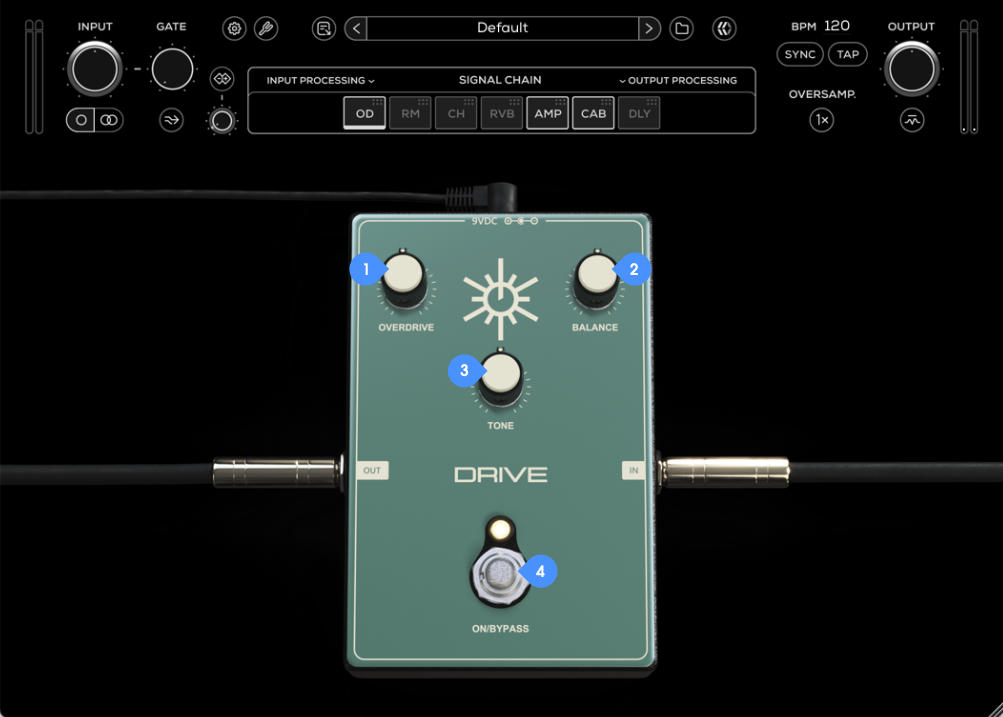
Overdrive - Adjusts the amount of overdrive to the input signal.
Balance - Adjusts the output level from the pedal.
Tone Knob - Controls the timbre and color of the sound.
Bypass Switch - Engages or disengages the Overdrive.
Chorus
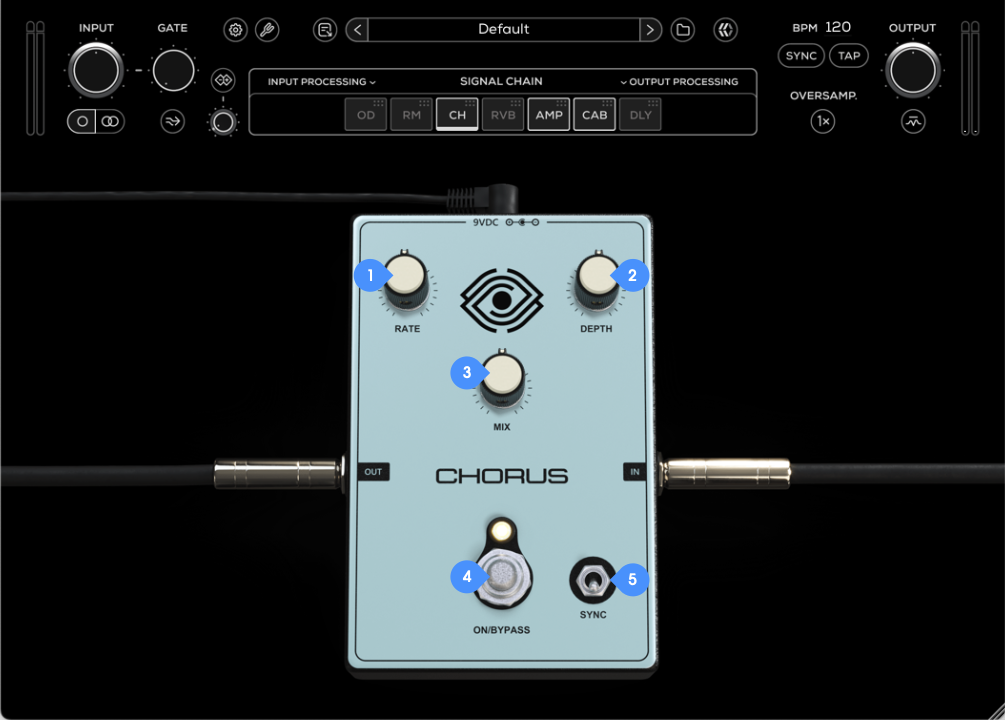
Rate Knob - Controls the frequency, or the speed of the oscillation. In manual mode, the range is from 0.01 Hz to 20 Hz. When Sync is enabled, the range will be from 8 to 1/32T.
Depth Knob - Controls the amplitude of the modulated signal. On minimum settings, the effect will be very subtle, almost inaudible.
Mix Knob - Controls the level of blend between the “dry” (clean) input signal and the “wet” (processed) signal.
Bypass Switch - Engages or disengages the Chorus.
Sync Switch - Enables synchronization of Rate to the host’s tempo in BPM.
Delay
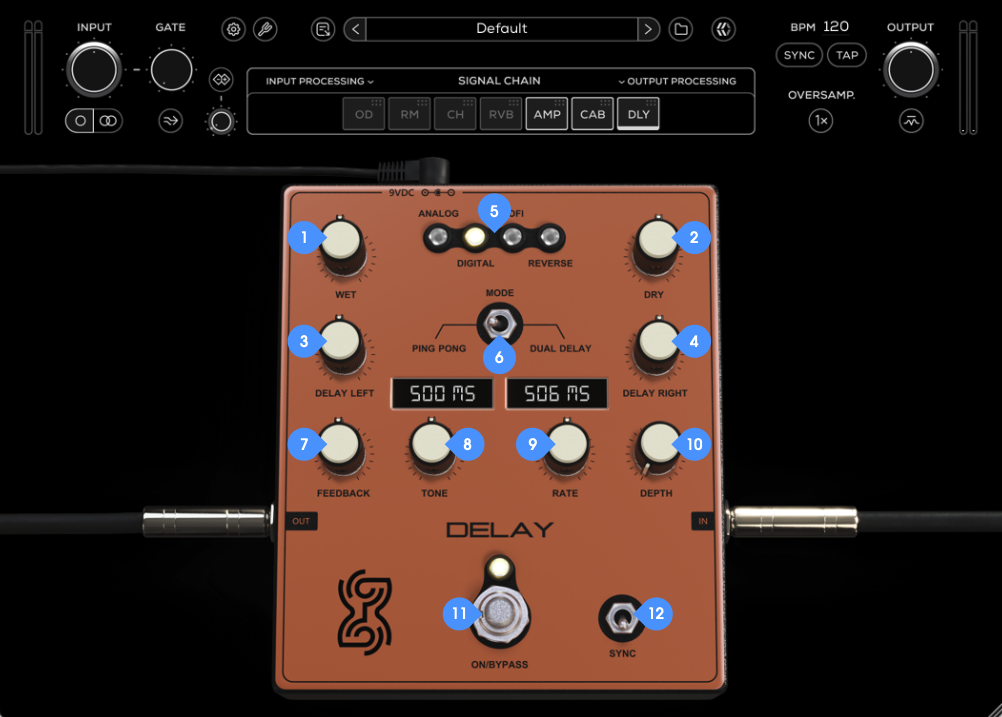
Wet Knob - Controls the level of the delayed (wet) signal.
Dry Knob - Controls the level of the original (dry) signal.
Delay Left - Sets the delay time in ms for the left channel. When Sync is enabled, it follows the host’s tempo in BPM.
Delay Right - Sets the delay time in ms for the right channel. When Sync is enabled, it follows the host’s tempo in BPM.
Delay Type - Select between “Analog”, “Digital”, “Lofi”, or “Reverse” delay.
Delay Mode - Choose between Ping Pong Delay and Dual Delay mode.
Feedback - Sets the amount of signal that is sent back into the effect.
Tone - Adjusts the tonality/timbre/color of the sound produced by the device.
Rate - Controls the speed of modulation. When Sync is enabled, it follows the host’s tempo in BPM.
Depth - Controls the height or amplitude of the modulation.
Bypass Switch - Engages or disengages the Delay.
Sync - When enabled, the Rate will synchronize to the host’s tempo in BP.
Reverb
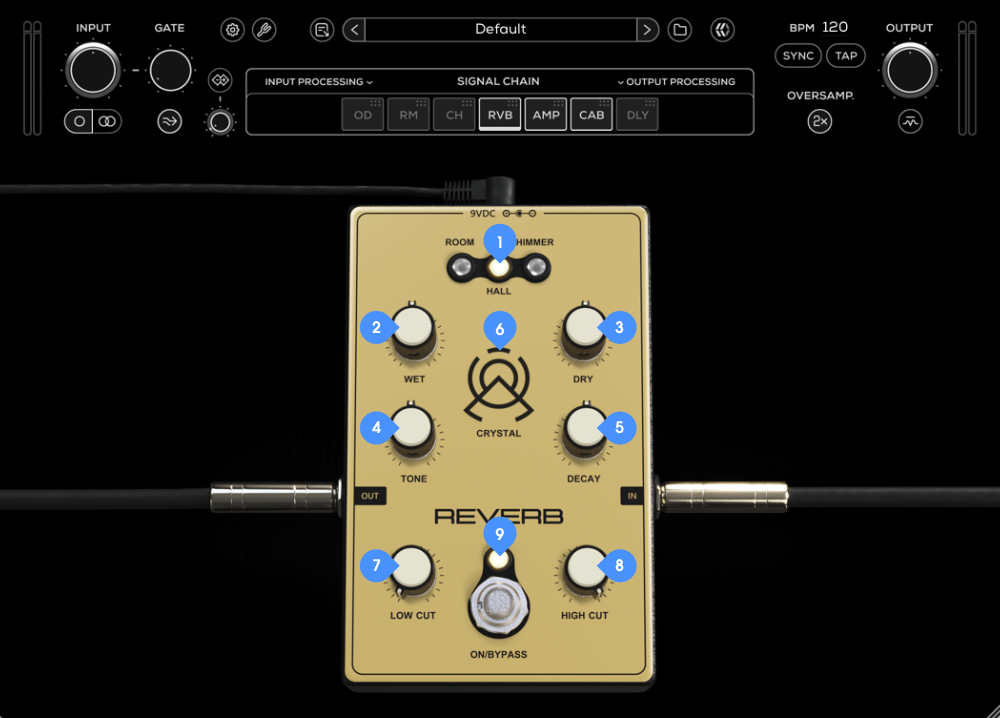
Reverb Type - Choose between a “Room”, “Hall”, or “Shimmer” reverb.
Wet Knob - Controls the level of the effected signal.
Dry Knob - Controls the level of the original signal.
Tone Knob - Adjusts the tone of the reverb from dark (left) to bright (right).
Decay Knob - Sets the amount and length of the reverb effect.
Crystal Knob - Adjusts the blended level of the Crystal effect.
Low Cut Knob - Rolls off low frequencies from 5 Hz to 1k Hz
High Cut Knob - Cuts high frequencies from 1k Hz to 20k Hz.
Bypass Switch - Engages or disengages the Reverb.
Ring Modulator
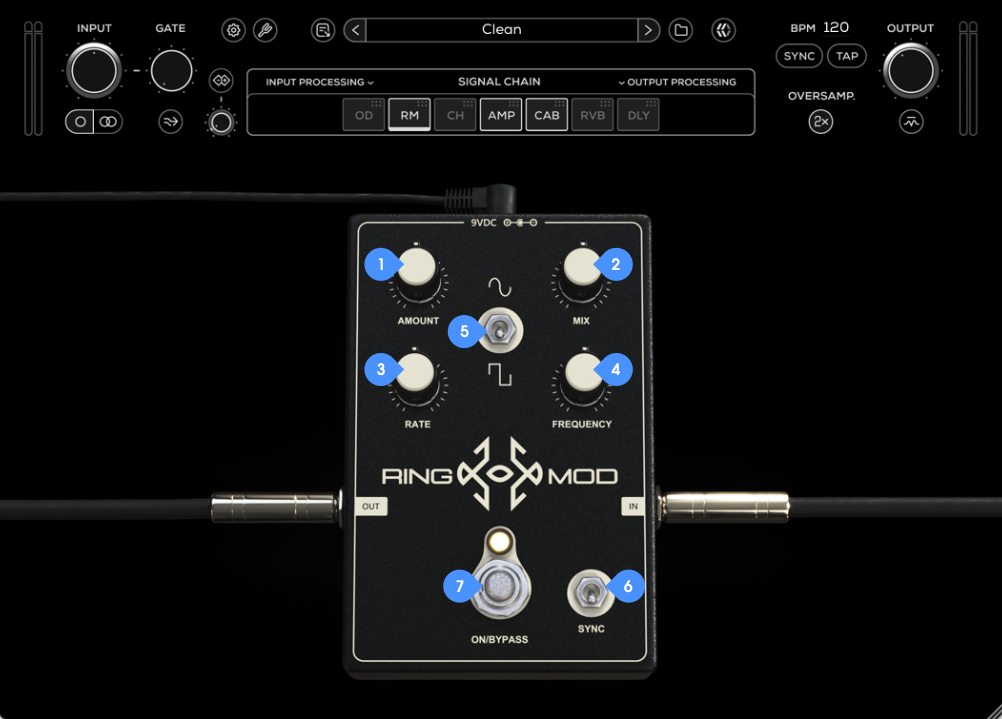
Amount Knob - Sets the amount of LFO.
Mix Knob - Controls the level of blend between the “dry” (clean) input signal and the “wet” (processed) signal.
Rate Knob - Controls the frequency, or the speed of the LFO oscillation. On manual mode, the range is from 0.01 Hz to 25 Hz. When Sync is enabled, the range will be from 8 to 1/32T.
Frequency Knob - Controls the frequency, or the speed of the Modulator oscillation.
Wave Type - Sets the wave type of LFO between Sine and Square.
Sync Switch - Enables synchronization of Rate to the host’s tempo in BPM.
Bypass Switch - Engages or disengages the Ring Modulator.
Amplifier
Clean
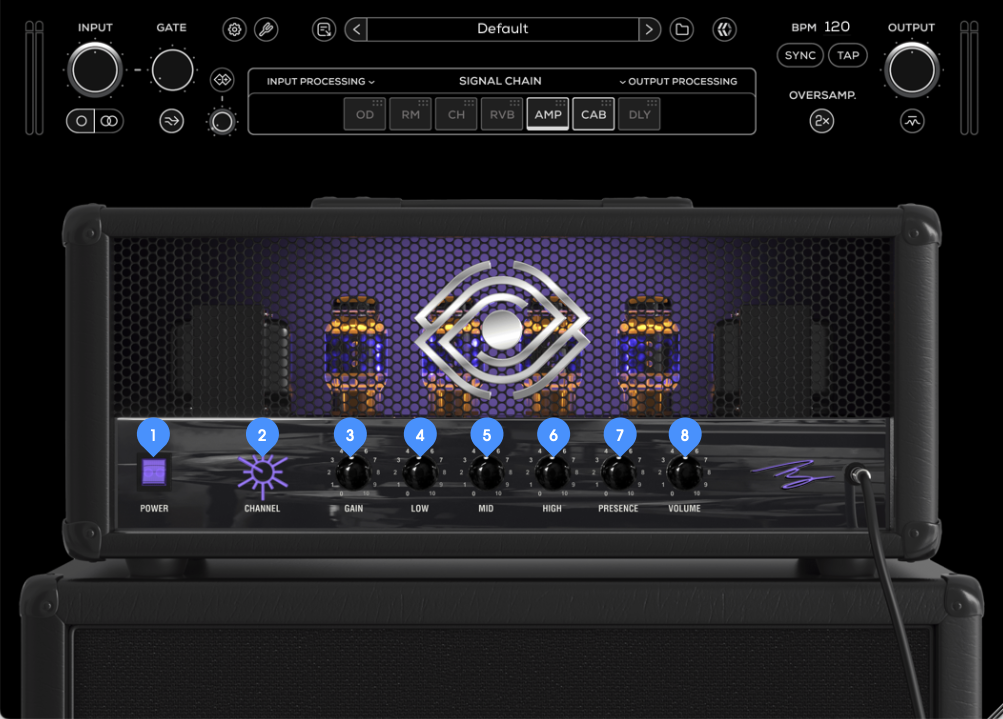
Power Switch - Turns the amplifier on or off.
Channel Selection Knob - Select between the Clean (left), Rhythm (middle) and Lead (right) Channels by turning the knob.
Gain Knob - Sets the input gain and the amount of distortion in the signal.
Low Knob - Adjusts the low frequency response of the amplifier.
Mid Knob - Adjusts the mid range frequency response of the amplifier.
High Knob - Adjusts the high frequency response of the amplifier.
Presence Knob - Adjusts the presence response of the amplifier.
Volume Knob - Adjust the amplifier output level.
Rhythm
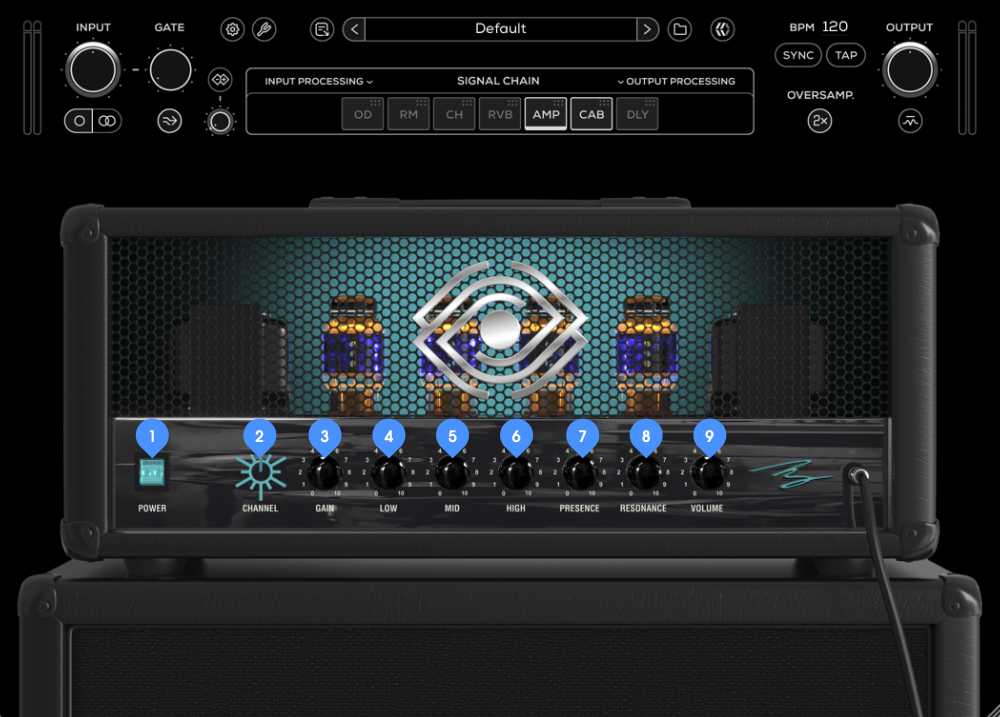
Power Switch - Turns the amplifier on or off.
Channel Selection Knob - Select between the Clean (left), Rhythm (middle) and Lead (right) Channels by turning the knob.
Gain Knob - Sets the input gain and the amount of distortion in the signal.
Low Knob - Adjusts the low frequency response of the amplifier.
Mid Knob - Adjusts the mid range frequency response of the amplifier.
High Knob - Adjusts the high frequency response of the amplifier.
Presence Knob - Adjusts the presence response of the amplifier
Resonance Knob - Cuts low frequencies in the negative feedback loop of the power amp.
Volume Knob - Adjust the amplifier output level.
Lead
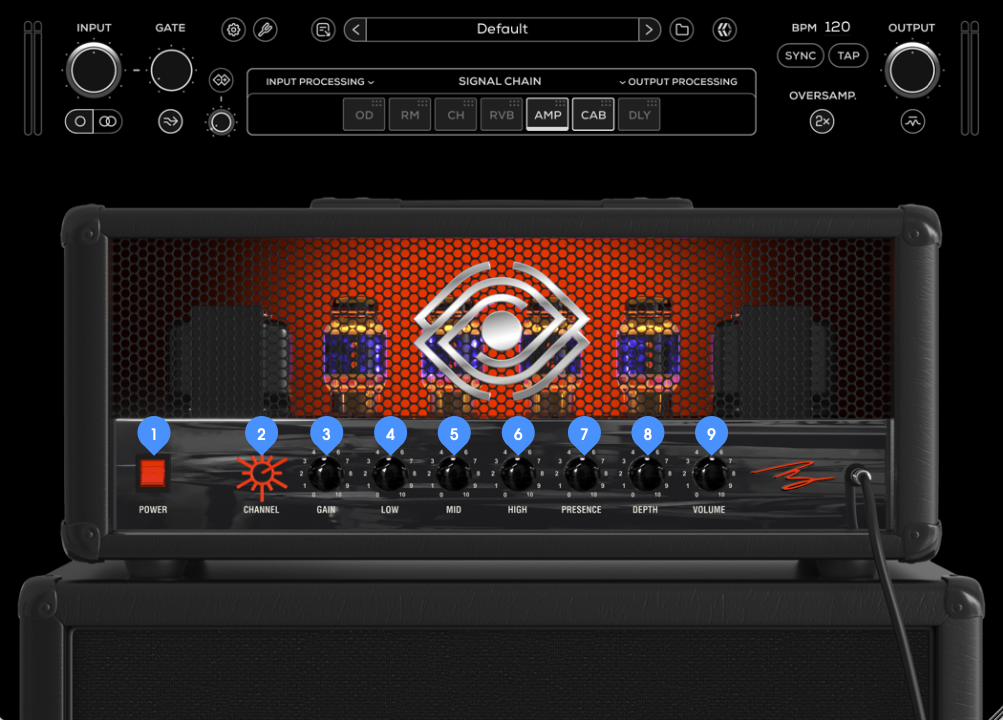
Power Switch - Turns the amplifier on or off.
Channel Selection Knob - Select between the Clean (left), Rhythm (middle) and Lead (right) Channels by turning the knob.
Gain Knob - Sets the input gain and the amount of distortion in the signal.
Low Knob - Adjusts the low frequency response of the amplifier.
Mid Knob - Adjusts the mid range frequency response of the amplifier.
High Knob - Adjusts the high frequency response of the amplifier.
Presence Knob - Adjusts the presence response of the amplifier
Depth Knob - Cuts low frequencies in the negative feedback loop of the power amp.
Volume Knob - Adjust the amplifier output level.
Speakers & Cabinets
The cab module features a 4x12 cabinet, accompanied by two speaker options and 21 virtual microphones.
The speaker and cabinet section of every MixWave amp plugin interface includes a range of features, outlined in the Amp Plugin Speakers & Cabinets article .
Microphones
Dynamic 57 – Punchy mids with a tight low end, a classic choice for aggressive guitar tones.
Dynamic 7B – Smooth and warm with a natural midrange, great for taming harshness.
Dynamic 409 – Fat and forward with a bit of bite, excels on crunchy and high-gain tones.
Dynamic 421 – Thick low-mids with a smooth top end, great for adding weight to your tone.
Dynamic 441 – Tight and articulate with a balanced frequency response, detailed without being harsh.
Dynamic R20 – Deep and warm with a tight low-end and reduced proximity effect, great for fuller tones.
Ribbon 84 – Classic ribbon warmth with a rich low-mid response and silky highs.
Tube 47 – Rich and full-bodied with a slight vintage warmth, great for adding depth.
Tube 67 – Warm and smooth with a slightly rolled-off top end, perfect for a vintage, rounded sound.
Tube 251 – Open and airy with a polished high end, adds clarity to darker tones.
Tube C12 – Bright and silky with a smooth top end, ideal for modern high-fidelity guitar tones.
Tube 800g – Crisp and present with an ultra-detailed high end, great for polished, articulate tones.
Condenser Fet 47 – Solid low-end punch with a clear top-end bite, great for aggressive tones.
Condenser 32 – Bright and detailed with a fast transient response, captures every nuance.
Condenser 4011 – Neutral and natural with extended highs, perfect for a true-to-life cab sound.
Condenser 2011 – Slightly forward mids with a clear and controlled top end.
Condenser 4099 – Detailed and focused, ideal for capturing articulation and harmonics.
Condenser 450 – Side-address condenser with a tight, present midrange, great for edge-of-cone positioning.
Ribbon 122 – Warm and smooth with extended highs, retains the natural body of the cab.
Ribbon 42Bn – Dark and vintage, smooths out high-end fizz while keeping a natural presence.
Copper – Lo-fi, midrange-focused with a unique honky character, great for creative textures.
Speakers
V30
Green
